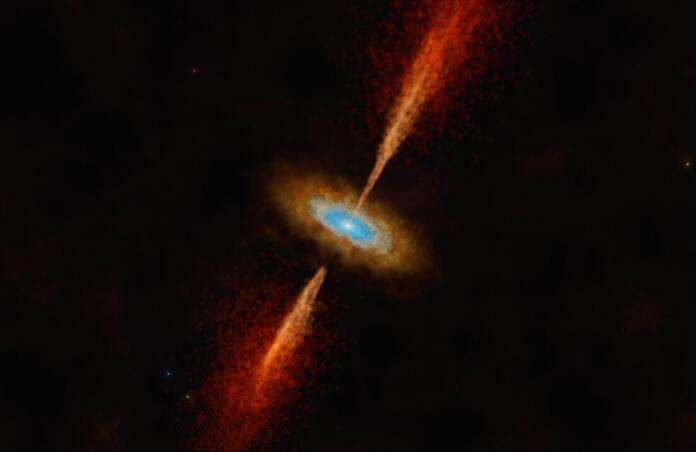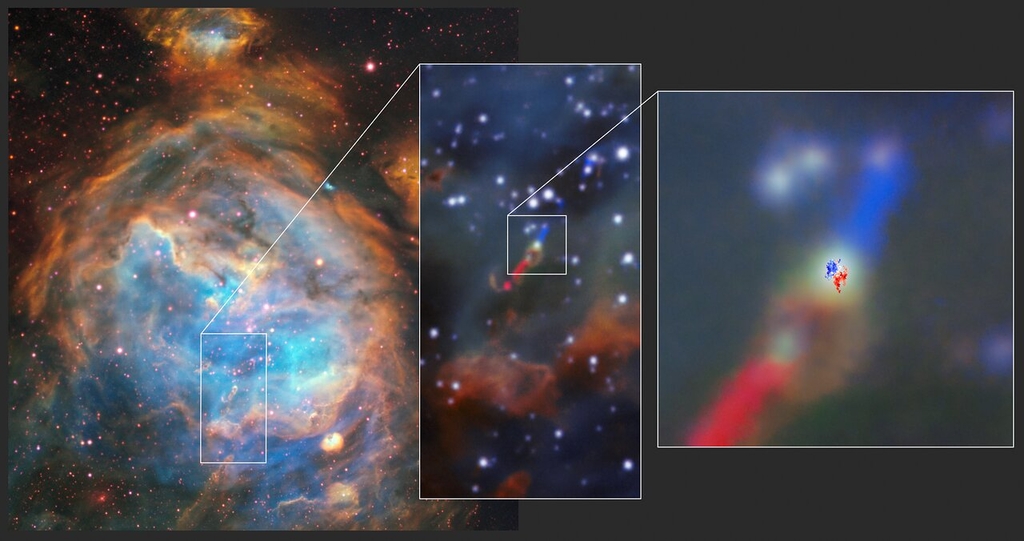Astronomers detect circumstellar disk around an extragalactic star

The first detection of a spinning disk structure around a young, massive extragalactic star has been made by a team of astronomers led by Durham University. The system named HH 1177 is situated in the stellar nursery N180, located 163,000 light years away in a neighbouring galaxy, the Large Magellanic Cloud. This makes it the most distant disk around a massive star to be directly detected.

The team first observed the motions of the gas around the young star using the Atacama Large Millimeter/submillimeter Array (ALMA) in Chile, deeming such motions consistent with a Keplerian accretion disk that powers the growth of stars through infalling material. They then took follow up observations using the Multi Unit Spectroscopic Explorer (MUSE) instrument on ESO’s Very Large Telescope, spotting a jet from the star in the process of forming. Thus, the system HH 1177 was born, found very deep inside a gas cloud in the Large Magellanic Cloud.
"We discovered a jet being launched from this young massive star, and its presence is a signpost for ongoing disc accretion," McLeod explains. However, the team needed to confirm this by studying the movement of the gas around the star. As matter is pulled towards a growing star, it can’t directly fall onto the star so flattens into a disk spinning around it. Its presence can be confirmed from the speed of such rotation, since the disk rotates faster closer to the centre. "The frequency of light changes depending on how fast the gas emitting the light is moving towards or away from us," explains Jonathan Henshaw, a research fellow at Liverpool John Moores University in the UK, and co-author of the study. "This is precisely the same phenomenon that occurs when the pitch of an ambulance siren changes as it passes you and the frequency of the sound goes from higher to lower." ALMA takes detailed frequency measurements, providing the team with the ability to determine the characteristic spin of the disk, and therefore confirming the existence of a disk around an extragalactic young star.
Dr Anna McLeod, lead author of the study from Center for Extragalactic Astronomy, Durham University said, "When I first saw evidence for a rotating structure in the ALMA data, I could not believe that we had detected the first extragalactic accretion disk; it was a special moment.”
Massive stars tend to live shorter lifetimes and form a lot quicker than low-mass stars like the sun. Within the milky way, observing these stars is a big challenge since our view is usually obstructed by the dusty material from which they are born at the time a disk would be forming around them. However, this system is optically visible, most likely due to the surrounding environment having a lower dust and metal content. Such a system thus allows astronomers to see the dynamics of accretion typically hidden away by dust and gas. Analysis of the disk points towards an inner Keplerian region that is transitioning to infalling material at larger distances from the central star, which is estimated to be 15 solar masses.
Despite the many similarities between the extragalactic disk and those in the milky way, this disk seems to be more stable against fragmentation, due to the low metal content of the LMC. Such a successful detection of its kind has boosted the probability of finding similar systems using ALMA, in addition to the upcoming Next Generation Very Large Array (ngVLA).
--
Cover image: European Southern Observatory
Journal source: Anna McLeod, A probable Keplerian disk feeding an optically revealed massive young star, Nature (2023). DOI: 10.1038/s41586-023-06790-2. www.nature.com/articles/s41586-023-06790-2
